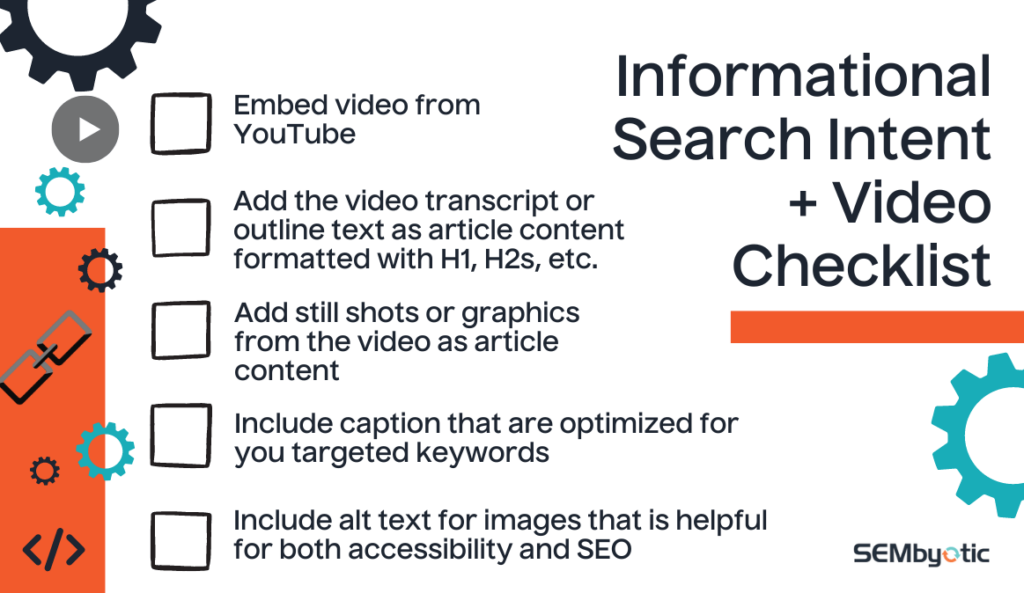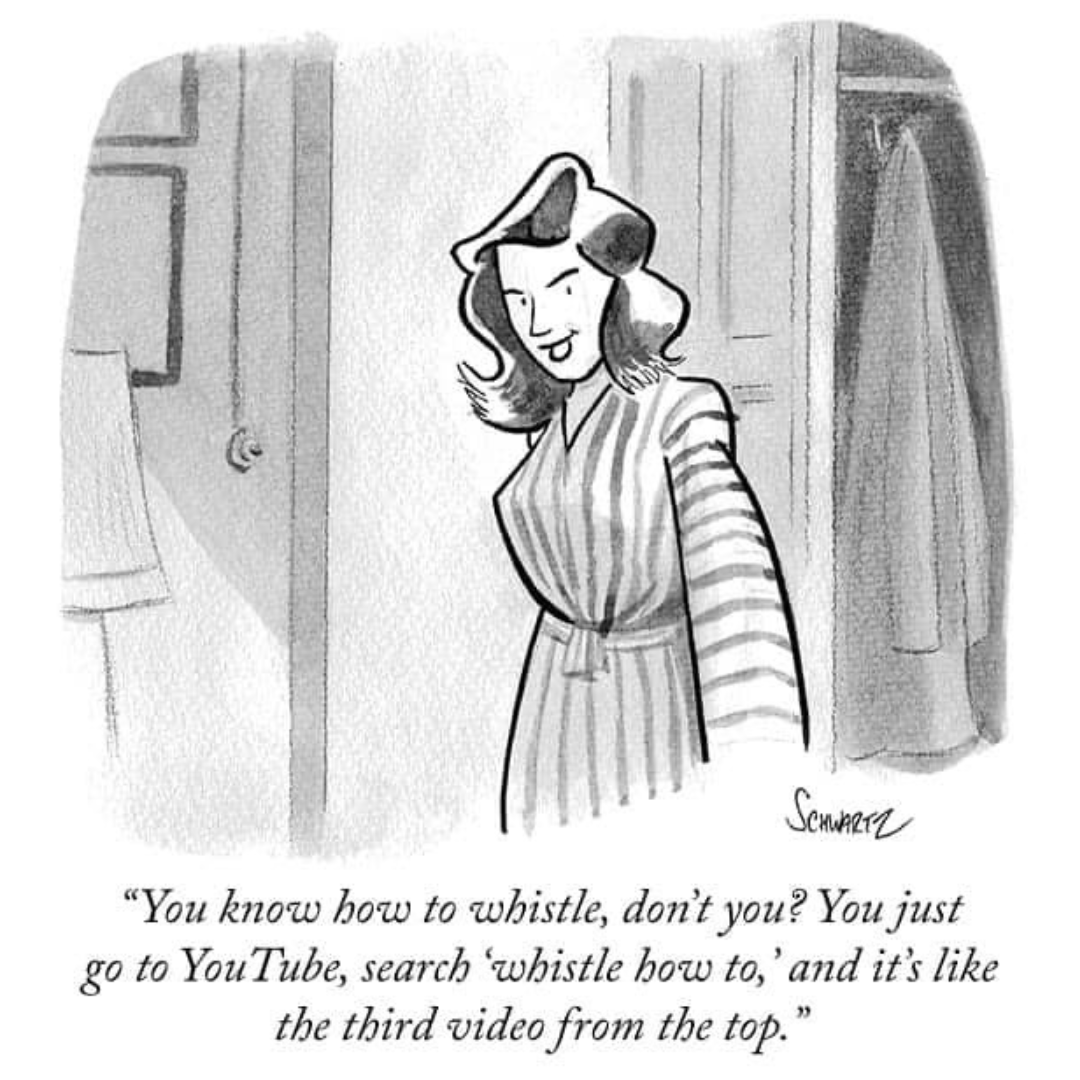
An Informational Intent SEO Strategy: Start With Video
One crucial aspect of any online strategy is search engine optimization (SEO). As search engines have grown more sophisticated, their ability to interpret the user’s intent has become an increasingly important factor in presenting the user with the right content at the right time.
Search engines like Google are looking at your past searches and online behaviors to determine if you want to educate yourself about a topic, buy a product or service, or maybe something else. These different “intent types” can be broken down into several categories: informational, navigational, commercial, and transactional.
For many of our B2B customers, the largest concentration of high-volume keywords falls into the informational search intent category. In this article, we’ll show you a strategy that leverages video to dramatically boost your rankings for these pages, and we’ll provide you with ways to make the whole process more efficient.
A Brief Overview of Search Intent
Search intent is Google’s way of identifying what the user was hoping to find when they entered their search query. One type of search intent, informational intent, is when people are looking for information on a topic. These queries are often more broadly searched keywords that lack the necessary modifiers, which gives the search engine more context. The results for these kinds of keyword searches often provide general knowledge to define what they mean or teach users more about the topic (e.g., Wikipedia).
We dig deeper into the different types of search intent in our article, How to Develop a Search Intent Content Plan.
Rich Media Matters
When it comes to choosing which content to rank, we know that Google prefers content that drives user engagement. Google is transparent about the fact that its content ranking system “is designed to present helpful, reliable information that’s primarily created to benefit people, not to gain search engine rankings.” So what benefits people looking to engage with your content? Adding visuals, interactive elements, and videos to your web page.
Furthermore, Google offers several types of search engines, including text, image, and video. As you and your competitors jockey for attention on Google, you can increase your odds of exposure by optimizing content to rank in more than just Google’s text search. I’ve personally noted a correlation between pages that rank in text search vs. images and videos that rank in those respective search engines.
Why Start With Video?
Your competitors may be overlooking the opportunity.
While it seems website managers are programmed to optimize for text search, optimizing other page elements, such as images and video, is often overlooked. Perhaps this is a function of the structure of marketing organizations where video creation is often considered a function of social media marketing and not generally considered a part of SEO or web management.
Your customers are searching for video content.
According to Think with Google, 80% of people say they switch between online search and video when researching products to buy. When people are researching solutions and gathering information about a potential purchase, they are actively seeking out videos to find answers.
You’ll improve time-on-page and other site metrics.
We know that Google takes certain metrics into consideration when evaluating the quality of your content. Factors such as the time users spend on your page and the number of backlinks to your content will affect your search ranking. Consider that according to Wistia people will spend, on average, 1.4 more time on a web page with video than without.
If you have video content, you have web page content.
If you consider the components of a well-optimized web page, we’re generally talking about text, images, and video. The process of creating a video typically involves developing similar creative elements — text, images, and video. It just makes good sense to leverage the development of that video creative to boost your SEO.
When you start a video project, the process will probably resemble something like this:
- Drafting an outline or storyboard
- Writing a script
- Creating visuals
- Supporting visuals with on-screen text
- Recording of voiceover or other audio
After the video is completed, you can use these building blocks from your video production to create and enhance your web page.
A Checklist for Adding Video Content and Optimizing it for Informational Search Intent
Once the video is created, businesses can use the visuals they’ve created as embedded images on their web page and then support them with relevant captions inspired by any on-screen text that was created for the video. This approach can improve the visual appeal of the website, keeping visitors engaged and on the site for longer.
The outline and text from the video can be adapted to an article format. This can help create a rich article that is supported with images and an embedded video. Such content has a higher chance of ranking in Google’s text search, image search, video search, and YouTube.
- Embed Video from YouTube (see below)
- Add the video transcript or outline text as article content formatted with H1, H2s, etc.
- Add still shots or graphics from the video as article content
- Include captions that are optimized for your targeted informational intent keywords
- Include alt text for the images that are helpful for both accessibility and SEO

DOWNLOAD AND SAVE THIS CHECKLIST TO OPTIMIZE YOUR VIDEO CONTENT FOR INFORMATIONAL SEARCH INTENT.
Bonus: Rank Your Topic on YouTube
Many people looking for information about a topic prefer to watch videos instead of reading web pages. And YouTube is the most common platform to find video content. Now that you have your video completed, you can post it on YouTube. Be sure to reference the URL of the new page you’ve created within the video’s description.
Conversely, you can embed this video within your page, which provides added context to search engines—impacting rankings in general search and in-video search.

An Investment in Video Will Pay Off
Starting an SEO content strategy with video can be a highly effective way for businesses to improve their online visibility and reach a wider audience. By creating high-quality video content and embedding it with relevant captions on their website, businesses can improve their website’s visual appeal. This will keep visitors engaged for longer. Leveraging the outline and text from the video to create a rich article with images and an embedded video can also increase the chances of ranking highly in search engine results pages (SERPs) across Google’s different search engines.
While creating high-quality video content may require more effort and resources upfront, the long-term benefits are real. The increased online visibility and improved SEO results can be significant. By following these tips, businesses can create engaging video content that supports their overall online strategy and helps them stand out in SERPs.